Prospective Review of Magneto-Resistive Current Sensors with High Sensitivity and Wide Temperature Range
Abstract
:1. Introduction
2. Principle and Structure of Magneto-Resistive Current Sensor
2.1. Principle of Magneto-Resistive Current Sensor
2.2. Open-Loop Current Sensor
2.3. Closed-Loop Current Sensor
2.4. Array Current Sensor
3. Characteristic Parameters of Current Sensor
3.1. Sensitivity
3.2. Operating Temperature Range
3.3. Accuracy
4. Magneto-Resistance (MR) Effect
4.1. Anisotropic Magneto-Resistance (AMR) Effect
4.2. Giant Magneto-Resistance (GMR) Effect

4.3. Tunneling Magneto-Resistance (TMR) Effect
4.4. Hall Effect
| Semiconductor Material | |||
|---|---|---|---|
| InSb | 80,000 | 9 × 1016 | 70 |
| InAs | 33,000 | 5 × 1016 | 125 |
| GaAs | 8500 | 1.45 × 1015 | 4.3 × 103 |
| Si | 1500 | 2.5 × 1015 | 2.5 × 103 |
5. Magnetic Current Sensors
5.1. Amplifier Circuit of the Current Sensor
| Sensors | Principle Type | Structure Type | Bandwidth | Accuracy | Operating Temperature | Application Scenario |
|---|---|---|---|---|---|---|
| MLX91209 | Hall | Open-loop | 200 kHz | 0.1% | −40~150 °C | EV |
| MLX91221 | Hall | Array | 300 kHz | N.A. | −40~125 °C | EV |
| TMR7303 | TMR | Open-loop | 500 kHz | 1% | −40~105 °C | Photovoltaic inverter |
| TMR7559 | TMR | Closed-loop | 300 kHz | 0.8% | −40~85 °C | UPS |
| MCx1101 | AMR | N.A. | 1.5 MHz | 0.7% | −40~150 °C | Industrial power system |
| MCx2101 | AMR | N.A. | 5 MHz | 3% | −40~125 °C | Photovoltaic inverter |
| ACS70331 | GMR | N.A. | 1 MHz | 2% | −40~85 °C | EV |
| ACS37002 | Hall | Array | 400 kHz | N.A. | −40~150 °C | EV |
| CSLS Series | Hall | Open-loop | N.A. | N.A. | −25~100 °C | UPS |
| CSNA Series | MR | Closed-loop | N.A. | 0.5% | 0~70 °C | UPS |
| [86] | Coil + Hall | Array | 1.8 MHz | N.A. | −40~85 °C | N.A. |
| [87] | AMR | Closed-loop | 500 kHZ | 0.25% | N.A. | Medium-voltage power electronics |
| [88] | GMR | Open-loop | N.A. | 0.8% | −40~125 °C | Smart grid |
| [89] | TMR | Open-loop | DC | 2% | −40~105 °C | DC busbar system |
| [90] | GMR | Closed-loop | 300 kHZ | 0.8% | N.A. | N.A. |
| Current-Mode Structure (Figure 18a) | Current-Feedback Structure (Figure 18b) | Capacitively Coupled Structure (Figure 18c) | Triple Op-Amp Structure (Figure 18d) | |
|---|---|---|---|---|
| Common-mode rejection ratio | Middle | High | High | High |
| Equivalent Input Noise | Middle | Low | Low | Low |
| Input Impedance | High | High | Low | High |
| Output Impedance | Middle | Low | High | Low |
5.2. Conditioning Circuit for Current Sensor
5.3. Applications of Current Sensors

6. Conclusions
Author Contributions
Funding
Data Availability Statement
Conflicts of Interest
References
- Brown, P.; Whiteside, B.J.; Beek, T.J.; Fox, P.; Horbury, T.S.; Oddy, T.M.; Archer, M.O.; Eastwood, J.P.; Sanz-Hernández, D.; Sample, J.G.; et al. Space magnetometer based on an anisotropic magnetoresistive hybrid sensor. Rev. Sci. Instrum. 2014, 85, 125117. [Google Scholar] [CrossRef] [PubMed]
- Sun, H.; Huang, S.; Peng, L. High-Current Sensing Technology for Transparent Power Grids: A Review. IEEE Open J. Ind. Electron. Soc. 2024, 5, 326–358. [Google Scholar] [CrossRef]
- Zhang, S. PCB Design of Rogowski Coil with Strong Anti-Electromagnetic Interference. In Proceedings of the 3rd Asia-Pacific Conference on Image Processing, Electronics and Computers, Dalian, China, 14–16 April 2022; pp. 478–485. [Google Scholar]
- Huang, Q.; Zhang, C.; Liu, Q.; Ning, Y.; Cao, Y. New type of fiber optic sensor network for smart grid interface of transmission system. In Proceedings of the IEEE PES General Meeting, Minneapolis, MN, USA, 25–29 July 2010; pp. 1–5. [Google Scholar]
- Lee, B. Review of the present status of optical fiber sensors. Opt. Fiber Technol. 2003, 9, 57–79. [Google Scholar] [CrossRef]
- Thompson, S.M. The discovery, development and future of GMR: The Nobel Prize 2007. J. Phys. D Appl. Phys. 2008, 41, 093001. [Google Scholar] [CrossRef]
- Xie, F.; Weiss, R.; Weigel, R. Improved mathematical operations based calibration method for giant magnetoresistive current sensor applying B-Spline modeling. Sens. Actuators A Phys. 2017, 254, 109–115. [Google Scholar] [CrossRef]
- McGuire, T.; Potter, R. Anisotropic magnetoresistance in ferromagnetic 3d alloys. IEEE Trans. Magn. 1975, 11, 1018–1038. [Google Scholar] [CrossRef]
- Ritzinger, P.; Výborný, K. Anisotropic magnetoresistance: Materials, models and applications. R. Soc. Open Sci. 2023, 10, 230564. [Google Scholar] [CrossRef]
- Yang, S.; Zhang, J. Current Progress of Magnetoresistance Sensors. Chemosensors 2021, 9, 211. [Google Scholar] [CrossRef]
- Ramsden, E. Hall-Effect Sensors: Theory and Applications; Newnes: Amsterdam, The Netherlands, 2006. [Google Scholar]
- Liu, X.; Lam, K.H.; Zhu, K.; Zheng, C.; Li, X.; Du, Y.; Liu, C.; Pong, P.W.T. Overview of Spintronic Sensors with Internet of Things for Smart Living. IEEE Trans. Magn. 2019, 55, 1–22. [Google Scholar] [CrossRef]
- Palneedi, H.; Annapureddy, V.; Priya, S.; Ryu, J. Status and Perspectives of Multiferroic Magnetoelectric Composite Materials and Applications. Actuators 2016, 5, 9. [Google Scholar] [CrossRef]
- Stoney, R.; Geraghty, D.; Donnell, G.E.O. Characterization of Differentially Measured Strain Using Passive Wireless Surface Acoustic Wave (SAW) Strain Sensors. IEEE Sens. J. 2014, 14, 722–728. [Google Scholar] [CrossRef]
- Thormählen, L.; Seidler, D.; Schell, V.; Munnik, F.; McCord, J.; Meyners, D. Sputter Deposited Magnetostrictive Layers for SAW Magnetic Field Sensors. Sensors 2021, 21, 8386. [Google Scholar] [CrossRef] [PubMed]
- Du, Y.; Liu, Q.; Huang, A.Q. A monolithic CMOS synchronous Buck converter with a fast and low-cost current sensing scheme. In Proceedings of the 2012 IEEE Energy Conversion Congress and Exposition (ECCE), Raleigh, NC, USA, 15–20 September 2012; pp. 1849–1856. [Google Scholar] [CrossRef]
- Zhang, Q.; Liu, J.; Yang, Y. A new complementary symmetrical structure of using dual magnetic cores for open loop Hall-Effect current sensors. In Proceedings of the PCIM Europe 2015, International Exhibition and Conference for Power Electronics, Intelligent Motion, Renewable Energy and Energy Management, Nuremberg, Germany, 19–20 May 2015; pp. 1–8. [Google Scholar]
- Zhou, L.; Chen, Q.; Li, H.; Yang, S.; Pang, D.; Deng, H. A Non-Contact Micro-Ampere DC Current Digital Sensor Based on the Open-Loop Structure. IEEE Sens. J. 2021, 21, 5923–5931. [Google Scholar] [CrossRef]
- Tan, C.; Wu, C.; Gong, X.; Li, X.; Fu, R.; Yue, Z. New Magnetic Circuit Structure of Hall Current Sensor for Reducing Conductor Position Error. Sens. Mater. 2020, 32, 2891. [Google Scholar] [CrossRef]
- Carretero, C.; Lope, I.; Acero, J. Magnetizable Concrete Flux Concentrators for Wireless Inductive Power Transfer Applications. IEEE J. Emerg. Sel. Top. Power Electron. 2020, 8, 2696–2706. [Google Scholar] [CrossRef]
- Morón, C.; Cabrera, C.; Morón, A.; García, A.; González, M. Magnetic Sensors Based on Amorphous Ferromagnetic Materials: A Review. Sensors 2015, 15, 28340–28366. [Google Scholar] [CrossRef] [PubMed]
- Khan, M.A.; Sun, J.; Li, B.; Przybysz, A.; Kosel, J. Magnetic sensors—A review and recent technologies. Eng. Res. Express 2021, 3, 022005. [Google Scholar] [CrossRef]
- Fish, G.E. Soft magnetic materials. Proc. IEEE 1990, 78, 947–972. [Google Scholar] [CrossRef]
- Li, Z.; Dixon, S. A Closed-Loop Operation to Improve GMR Sensor Accuracy. IEEE Sens. J. 2016, 16, 6003–6007. [Google Scholar] [CrossRef]
- Parsa Sirat, A.; Parkhideh, B. Current Sensor Integration Issues with Wide-Bandgap Power Converters. Sensors 2023, 23, 6481. [Google Scholar] [CrossRef]
- Storms, W.; Shockley, J.; Raquet, J. Magnetic field navigation in an indoor environment. In Proceedings of the 2010 Ubiquitous Positioning Indoor Navigation and Location Based Service, Kirkkonummi, Finland, 14–15 October 2010; pp. 1–10. [Google Scholar] [CrossRef]
- Hu, C.; Li, M.; Song, S.; Yang, W.; Zhang, R.; Meng, M.Q.H. A Cubic 3-Axis Magnetic Sensor Array for Wirelessly Tracking Magnet Position and Orientation. IEEE Sens. J. 2010, 10, 903–913. [Google Scholar] [CrossRef]
- Yang, A.; Liu, M.; Wang, Y.; Wu, Y.; Zhu, L.; Fan, Y. Research on High-Frequency Current Sensor and Measurement Method Based on Magnetic Sensor Array. In Proceedings of the 2023 12th International Conference of Information and Communication Technology (ICTech), Wuhan, China, 14–16 April 2023; pp. 556–562. [Google Scholar]
- Leroy, P.; Coillot, C.; Mosser, V.; Roux, A.; Chanteur, G. Use of Magnetic Concentrators to Highly Improve the Sensitivity of Hall Effect Sensors. Sens. Lett. 2007, 5, 162–166. [Google Scholar] [CrossRef]
- Navau, C.; Mach-Batlle, R.; Parra, A.; Prat-Camps, J.; Laut, S.; Del-Valle, N.; Sanchez, A. Enhancing the sensitivity of magnetic sensors by 3D metamaterial shells. Sci. Rep. 2017, 7, 44762. [Google Scholar] [CrossRef]
- Gobbi, M.; Orgiu, E. The Rise of the Organic Magnetoresistance: Materials and Challenges. J. Mater. Chem. C 2017, 5, 5572–5580. [Google Scholar] [CrossRef]
- Zheng, X.Q.; Wu, H.; Chen, J.; Zhang, B.; Li, Y.Q.; Hu, F.X.; Sun, J.R.; Huang, Q.Z.; Shen, B.G. The physical mechanism of magnetic field controlled magnetocaloric effect and magnetoresistance in bulk PrGa compound. Sci. Rep. 2015, 5, 14970. [Google Scholar] [CrossRef] [PubMed]
- Ma, J.; Hu, J.; Li, Z.; Nan, C.W. Recent Progress in Multiferroic Magnetoelectric Composites: From Bulk to Thin Films (Adv. Mater. 9/2011). Adv. Mater. 2011, 23, 1061. [Google Scholar] [CrossRef]
- Tan, J.; Zhang, X.; Chen, L. Accurate measurement technology for magnetic field based on AMR sensor SET/RESET function. China Meas. Test 2018, 44, 88–92. [Google Scholar]
- Pei, Y.; Yu, N.; Liu, Q.; Liu, J. Theory and Application of Anisotropic Magnetoresistive Sensor. Intstrument Tech. Sens. 2004, 8, 26–27. [Google Scholar]
- Brown, P.; Beek, T.; Carr, C.; O’Brien, H.; Cupido, E.; Oddy, T.; Horbury, T.S. Magnetoresistive magnetometer for space science applications. Meas. Sci. Technol. 2012, 23, 025902. [Google Scholar] [CrossRef]
- Li, T.; Zhang, L.; Hong, X. Anisotropic magnetoresistance and planar Hall effect in correlated and topological materials. J. Vac. Sci. Technol. A 2022, 40, 010807. [Google Scholar] [CrossRef]
- Zhang, X.; Yang, G.; Lai, Z.; Zhao, D. High-Precision Measuring Technique of AMR Magnetic Sensor. J. Test Meas. Technol. 2015, 29, 73–77. [Google Scholar]
- Quynh, L.K.; Tu, B.D.; Dang, D.X.; Viet, D.Q.; Hien, L.T.; Huong Giang, D.T.; Duc, N.H. Detection of magnetic nanoparticles using simple AMR sensors in Wheatstone bridge. J. Sci. Adv. Mater. Devices 2016, 1, 98–102. [Google Scholar] [CrossRef]
- Mlejnek, P.; Vopálenský, M.; Ripka, P. AMR current measurement device. Sens. Actuators A Phys. 2008, 141, 649–653. [Google Scholar] [CrossRef]
- Yin, D.; Zhang, X.; Kwan, K.H.; Wang, G. Research of Current Measurement System Based on Two-axis Anisotropic Magnetoresistive Sensor. J. Power Supply 2018, 16, 178–184. [Google Scholar] [CrossRef]
- Belyakov, P.; Amelichev, V.; Kostyuk, D.; Kazakov, Y.; Orlov, E.; Zhukov, D.; Vasilyev, D. Current Sensor Based on Anisotropic Magnetoresistive Effect. IEEE Trans. Magn. 2021, 57, 1–4. [Google Scholar] [CrossRef]
- Ripka, P.; Janosek, M. Advances in Magnetic Field Sensors. IEEE Sens. J. 2010, 10, 1108–1116. [Google Scholar] [CrossRef]
- Baibich, M.N.; Broto, J.M.; Fert, A.; Van Dau, F.N.; Petroff, F.; Etienne, P.; Creuzet, G.; Friederich, A.; Chazelas, J. Giant magnetoresistance of (001)Fe/(001)Cr magnetic superlattices. Phys. Rev. Lett. 1988, 61, 2472–2475. [Google Scholar] [CrossRef]
- Grünberg, P.E.; Schreiber, R.; Pang, Y.; Brodsky, M.B.; Sowers, H. Layered magnetic structures: Evidence for antiferromagnetic coupling of Fe layers across Cr interlayers. Phys. Rev. Lett. 1986, 57, 2442–2445. [Google Scholar] [CrossRef]
- Noh, E.S.; Lee, H.M.; Ulloa, S. A theoretical study of the effect of electronic structures of ferromagnets on giant magnetoresistance. J. Korean Phys. Soc. 2006, 48, 451–459. [Google Scholar]
- Becker, C.; Karnaushenko, D.; Kang, T.; Karnaushenko, D.D.; Faghih, M.; Mirhajivarzaneh, A.; Schmidt, O.G. Self-assembly of highly sensitive 3D magnetic field vector angular encoders. Sci. Adv. 2019, 5, eaay7459. [Google Scholar] [CrossRef]
- Adem, S.; Jain, S.; Sveiven, M.; Zhou, X.; O’Donoghue, A.J.; Hall, D.A. Giant magnetoresistive biosensors for real-time quantitative detection of protease activity. Sci. Rep. 2020, 10, 7941. [Google Scholar] [CrossRef]
- Daughton, J.M.; Chen, Y.J. GMR materials for low-field applications. IEEE Trans. Magn. 1993, 29, 2705–2710. [Google Scholar] [CrossRef]
- Bonavolonta, C.; Valentino, M.; Penta, F.; Granata, C.; Ruggiero, B.; Silvestrini, P.; Vettoliere, A. Detection of Magnetomechanical Effect in Structural Steel Using GMR 2nd Order Gradiometer Based Sensors. Sensors 2019, 19, 4147. [Google Scholar] [CrossRef] [PubMed]
- Li, Q.; Wolfs, P. A review of the single phase photovoltaic module integrated converter topologies with three different dc link configurations. IEEE Trans. Power Electron. 2008, 23, 1320–1333. [Google Scholar] [CrossRef]
- Qian, Z.H.; Wang, D.X.; Daughton, J.M.; Tondra, M.; Nordman, C.; Popple, A. Linear spin-valve bridge sensing devices. IEEE Trans. Magn. 2004, 40, 2643–2645. [Google Scholar] [CrossRef]
- Takeo, A.; Taguchi, T.; Sakai, Y.; Tanaka, Y. Characterization of GMR nonlinear response and the impact on BER in perpendicular magnetic recording. IEEE Trans. Magn. 2004, 40, 2582–2584. [Google Scholar] [CrossRef]
- Reig, C.; Cubells-Beltrán, M.-D.; Ramírez Muñoz, D. Magnetic Field Sensors Based on Giant Magnetoresistance (GMR) Technology: Applications in Electrical Current Sensing. Sensors 2009, 9, 7919–7942. [Google Scholar] [CrossRef]
- Yang, X.; Xie, C.; Wang, Y.; Wang, Y.; Yang, W.; Dong, G. Optimization Design of a Giant Magneto Resistive Effect Based Current Sensor with a Magnetic Shielding. IEEE Trans. Appl. Supercond. 2014, 24, 1–4. [Google Scholar] [CrossRef]
- Yang, X.; Liu, H.; Wang, Y.; Wang, Y.; Dong, G.; Zhao, Z. A Giant Magneto Resistive (GMR) Effect Based Current Sensor with a Toroidal Magnetic Core as Flux Concentrator and Closed-Loop Configuration. IEEE Trans. Appl. Supercond. 2014, 24, 1–5. [Google Scholar] [CrossRef]
- Wang, X.; Ren, S.; Yang, H.; Wang, B. FEM Analysis of Magnetic Shielding Effectiveness. Acta Metrol. Sin. 2006, 27, 376–379. [Google Scholar]
- Musuroi, C.; Oproiu, M.; Volmer, M.; Neamtu, J.; Avram, M.; Helerea, E. Low Field Optimization of a Non-Contacting High-Sensitivity GMR-Based DC/AC Current Sensor. Sensors 2021, 21, 2564. [Google Scholar] [CrossRef]
- Borole, U.P.; Barshilia, H.C.; Ananda, C.M.; Chowdhury, P. Design, Development, and Performance Evaluation of GMR-Based Current Sensor for Industrial and Aerospace Applications. IEEE Sens. J. 2023, 23, 12687–12694. [Google Scholar] [CrossRef]
- Musuroi, C.; Oproiu, M.; Volmer, M.; Firastrau, I. High Sensitivity Differential Giant Magnetoresistance (GMR) Based Sensor for Non-Contacting DC/AC Current Measurement. Sensors 2020, 20, 323. [Google Scholar] [CrossRef] [PubMed]
- Ouyang, Y.; Wang, Z.; Zhao, G.; Hu, J.; Ji, S.; He, P.; Wang, S.X. Current sensors based on GMR effect for smart grid applications. Sens. Actuators A-Phys. 2019, 294, 8–16. [Google Scholar] [CrossRef]
- Wang, H.; Guo, H.; Wang, Y.; Wang, Z.; Guo, Y. Research of current sensor based on TMR device. Electr. Meas. Instrum. 2018, 55, 103–107. [Google Scholar]
- Jilili, J.; Sadeh, B. Principle and Application of Tunneling Magnetoresistance Effect. Mater. Rep. 2009, 23, 338–340+349. [Google Scholar]
- Ouyang, Y.; He, J.; Hu, J.; Zhao, G.; Wang, Z.; Wang, S.X. Contactless Current Sensors Based on Magnetic Tunnel Junction for Smart Grid Applications. IEEE Trans. Magn. 2015, 51, 1–4. [Google Scholar] [CrossRef]
- Li, Y.-B.; Wei, F.-L.; Zheng, Y. Tunnelling magnetoresistance effects of magnetic tunnel junctions. Physics 2009, 38, 420–426. [Google Scholar]
- Zhang, P.; Li, Q.; Zhang, W.; Liu, C. Study on Design of Tunneling Magnetoresistance Current Sensor. Instrum. Tech. Sens. 2019, 12, 23–26. [Google Scholar]
- Lei, M.; Peng, T.; Yu, J.; Zhou, F.; Liu, J.; Li, L. Optimal design and implementation of tunnelling magnetoresistance based small current sensor with temperature compensation. Energy Rep. 2022, 8, 137–146. [Google Scholar] [CrossRef]
- Chen, J.Y.; Carroll, N.; Feng, J.F.; Coey, J.M.D. Yoke-shaped MgO-barrier magnetic tunnel junction sensors. Appl. Phys. Lett. 2012, 101, 262402. [Google Scholar] [CrossRef]
- Yu, H.; Chang, W.; Du, F.; Wang, G. Research on Anti-Interference Principle of Current Sensor Based on Circular Array of TMR. Electr. Power Inf. Commun. Technol. 2020, 18, 7–14. [Google Scholar] [CrossRef]
- Xu, X.P.; Wang, S.; Liu, T.Z.; Zhu, M.; Wang, J.G. TMR Busbar Current Sensor with Good Frequency Characteristics. IEEE Trans. Instrum. Meas. 2021, 70, 1–9. [Google Scholar] [CrossRef]
- Yu, Z.; Wang, J.; Chen, W.; Ye, K. Micro Contactless High Voltage Current Sensor Based on TMR. Power Electron. 2022, 56, 51. [Google Scholar]
- Pavel, R. Magnetic Sensors and Magnetometers, 2nd ed.; Artech: Dallas, TX, USA, 2021; p. 1. [Google Scholar]
- Beer, A.C.; Morgan, K.Z.; Peters, R.W.; Dittman, R.H.; Phillips, N.E.; Eckert, E.R.G.; Loeb, A.L.; Trump, J.G.; Hujer, K.; Smith, H.M.H. The Encyclopedia of Physics; Besançon, R.M., Ed.; Springer: Boston, MA, USA, 1990; pp. 538–573. [Google Scholar]
- Ellmer, K. Hall Effect and Conductivity Measurements in Semiconductor Crystals and Thin Films. In Characterization of Materials; John Wiley & Sons Inc.: Hoboken, NJ, USA, 2012; pp. 1–16. [Google Scholar]
- Xie, Z.; Gu, Y. Research on Temperature Compensation of Open-loop Hall Current Sensor Based on STM32. Optoelectron. Technol. 2020, 40, 63–69. [Google Scholar] [CrossRef]
- Qin, Z.; Lu, W.; Zuo, F.; Feng, Y. Temperature Compensation of Hall Effect Displacement Sensor. Chin. J. Sens. Actuators 2019, 32, 1040–1044. [Google Scholar]
- Crescentini, M.; Syeda, S.F.; Gibiino, G.P. Hall-Effect Current Sensors: Principles of Operation and Implementation Techniques. IEEE Sens. J. 2022, 22, 10137–10151. [Google Scholar] [CrossRef]
- Velasco-Quesada, G.; Román-Lumbreras, M.; Conesa-Roca, A.; Jeréz, F. Design of a Low-Consumption Fluxgate Transducer for High-Current Measurement Applications. IEEE Sens. J. 2011, 11, 280–287. [Google Scholar] [CrossRef]
- Ripka, P.; Draxler, K.; Styblikova, R. Measurement of DC Currents in the Power Grid by Current Transformer. IEEE Trans. Magn. 2013, 49, 73–76. [Google Scholar] [CrossRef]
- Itzke, A.; Weiss, R.; Weigel, R. Influence of the Conductor Position on a Circular Array of Hall Sensors for Current Measurement. IEEE Trans. Ind. Electron. 2019, 66, 580–585. [Google Scholar] [CrossRef]
- Gao, J.; Wang, J.; Zhang, L.; Yu, Q.; Huang, Y.; Shen, Y. Magnetic Signature Analysis for Smart Security System Based on TMR Magnetic Sensor Array. IEEE Sens. J. 2019, 19, 3149–3155. [Google Scholar] [CrossRef]
- Xiang, Q.; Yue, C.; Hu, C.; Zhu, K.; Gong, H.; Wang, H. Hall effect element array based current measurement system. Electr. Meas. Instrum. 2017, 54, 105–110. [Google Scholar]
- Zhang, H.; Liu, X.; Wang, X.; Huo, M. Principles and applications of magneto-resistance effect. J. Harbin Inst. Technol. 2008, 40, 362–366. [Google Scholar]
- He, X. Design of a high-performance differential amplifier for collecting electrocardiogram signals. In Proceedings of the 2023 IEEE 6th International Conference on Information Systems and Computer Aided Education (ICISCAE), Dalian, China, 23–25 September 2023; pp. 805–810. [Google Scholar]
- Zhang, S.; Zhou, X.; Gao, C.; Li, Q. A 130-dB CMRR Instrumentation Amplifier With Common-Mode Replication. IEEE J. Solid-State Circuits 2022, 57, 278–289. [Google Scholar] [CrossRef]
- Jouyaeian, A.; Fan, Q.; Motz, M.; Ausserlechner, U.; Makinwa, K.A.A. 5.6 A 25 A Hybrid Magnetic Current Sensor with 64 mA Resolution, 1.8 MHz Bandwidth, and a Gain Drift Compensation Scheme. In Proceedings of the 2021 IEEE International Solid-State Circuits Conference (ISSCC), San Francisco, CA, USA, 13–22 February 2021; pp. 82–84. [Google Scholar]
- Ravi, L.; Liu, J.; Schmalz, S.; Schroedermeier, A.; Burgos, R.; Dong, D. A Compact Anisotropic Magnetoresistance Based Contactless Current Sensor for Medium Voltage Power Electronics Applications. In Proceedings of the 2023 IEEE Applied Power Electronics Conference and Exposition (APEC), Orlando, FL, USA, 19–23 March 2023; pp. 1670–1675. [Google Scholar]
- Xu, A.; Wang, Z.; Li, P.; Li, L.; Hao, C. Research and Application of Micro Current Sensor Based on Giant Magnetoresistance Effect. South. Power Syst. Technol. 2020, 14, 33–40. [Google Scholar]
- Xu, X.P.; Liu, T.Z.; Zhu, M.; Wang, J.G. New Small-Volume High-Precision TMR Busbar DC Current Sensor. IEEE Trans. Magn. 2020, 56, 1–5. [Google Scholar] [CrossRef]
- Yang, X.; Wen, J.; Xie, C.; Gao, Z.; Li, Y.; Xi, L. Design and Experimental Study of a Current Sensor Based on Multilayer GMR Material. Chin. J. Sens. Actuators 2020, 33, 12–16. [Google Scholar]
- Lin, T.N.; Wang, B.; Bermak, A. Review and Analysis of Instrumentation Amplifier for IoT Applications. In Proceedings of the 2018 IEEE 61st International Midwest Symposium on Circuits and Systems (MWSCAS), Windsor, ON, Canada, 5–8 August 2018; pp. 258–261. [Google Scholar]
- Bahubalindruni, P.G.; Martins, J.; Santa, A.; Tavares, V.; Martins, R.; Fortunato, E.; Barquinha, P. High-Gain Transimpedance Amplifier for Flexible Radiation Dosimetry Using InGaZnO TFTs. IEEE J. Electron Devices Soc. 2018, 6, 760–765. [Google Scholar] [CrossRef]
- Habib, S.; Khan, M.M.; Abbas, F.; Ali, A.; Faiz, M.T.; Ehsan, F.; Tang, H. Contemporary trends in power electronics converters for charging solutions of electric vehicles. CSEE J. Power Energy Syst. 2020, 6, 911–929. [Google Scholar] [CrossRef]
- Safayatullah, M.; Elrais, M.T.; Ghosh, S.; Rezaii, R.; Batarseh, I. A Comprehensive Review of Power Converter Topologies and Control Methods for Electric Vehicle Fast Charging Applications. IEEE Access 2022, 10, 40753–40793. [Google Scholar] [CrossRef]
- Nizam, M.; Maghfiroh, H.; Rosadi, R.A.; Kusumaputri, K.D.U. Battery management system design (BMS) for lithium ion batteries. In AIP Conference Proceedings; AIP Publishing: Melville, NY, USA, 2020; Volume 2217. [Google Scholar] [CrossRef]
- Zhu, Y.; Bai, J. Research on the Application of Sensor Technology in Electric Vehicle BMS. Auto Electr. Parts 2021, 8, 17–20. [Google Scholar] [CrossRef]
- Waseem, M.; Ahmad, M.; Parveen, A.; Suhaib, M. Battery technologies and functionality of battery management system for EVs: Current status, key challenges, and future prospectives. J. Power Sources 2023, 580, 233349. [Google Scholar] [CrossRef]
- Gabbar, H.A.; Othman, A.M.; Abdussami, M.R. Review of Battery Management Systems (BMS) Development and Industrial Standards. Technologies 2021, 9, 28. [Google Scholar] [CrossRef]
- Xia, K.; Ni, J.; Ye, Y.; Xu, P.; Wang, Y. A real-time monitoring system based on ZigBee and 4G communications for photovoltaic generation. CSEE J. Power Energy Syst. 2020, 6, 52–63. [Google Scholar] [CrossRef]
- Lazzaretti, A.E.; Costa, C.H.d.; Rodrigues, M.P.; Yamada, G.D.; Lexinoski, G.; Moritz, G.L.; Oroski, E.; Goes, R.E.d.; Linhares, R.R.; Stadzisz, P.C.; et al. A Monitoring System for Online Fault Detection and Classification in Photovoltaic Plants. Sensors 2020, 20, 4688. [Google Scholar] [CrossRef] [PubMed]
- Beránek, V.; Olšan, T.; Libra, M.; Poulek, V.; Sedláček, J.; Dang, M.-Q.; Tyukhov, I.I. New Monitoring System for Photovoltaic Power Plants’ Management. Energies 2018, 11, 2495. [Google Scholar] [CrossRef]
- Gao, J.; He, Y.; Luo, Q.; Huang, Y.; Cheng, T. Online Monitoring Technique for Photovoltaic Inverter. Instrum. Tech. Sens. 2018, 10, 47–50. [Google Scholar]

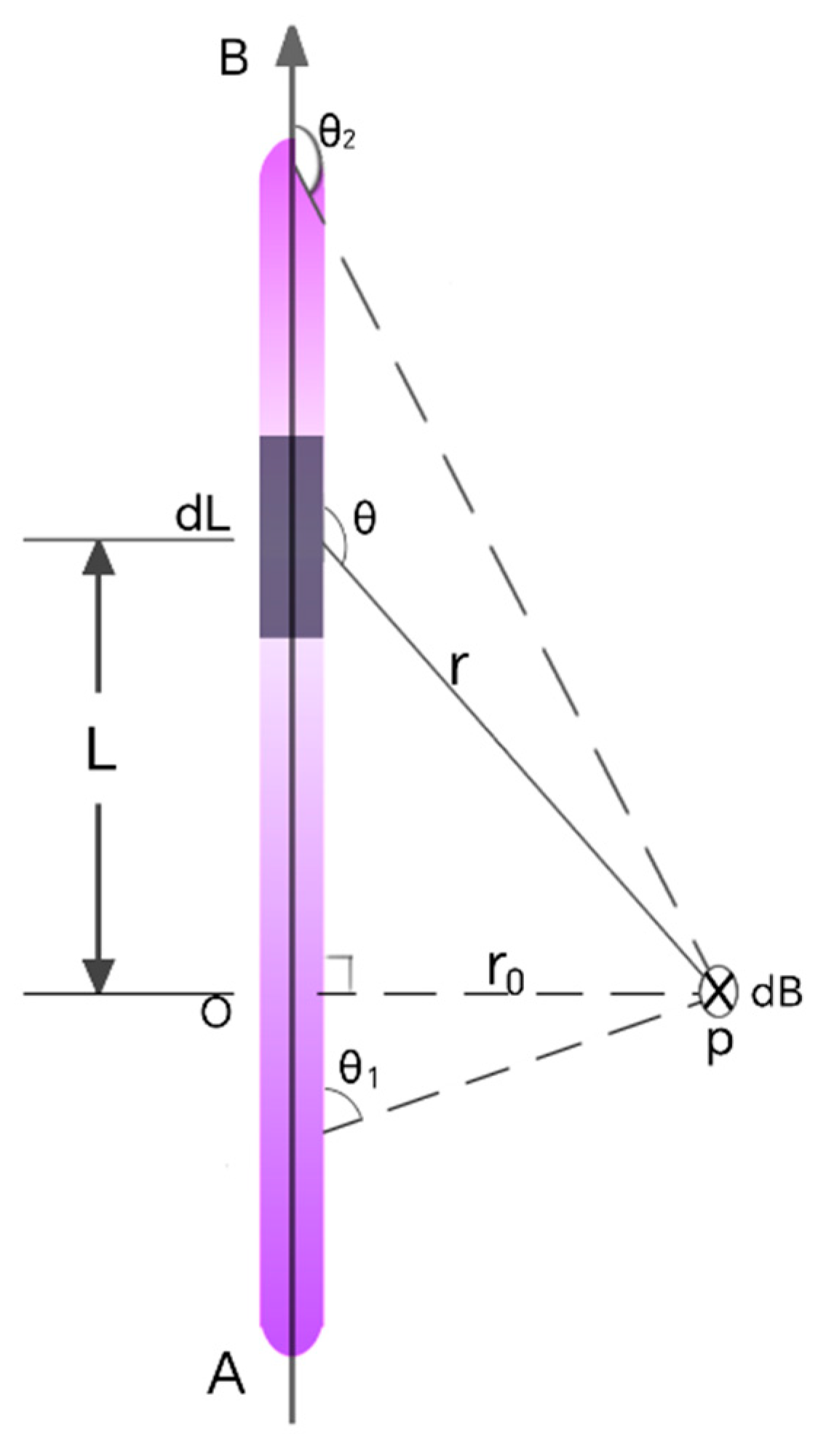

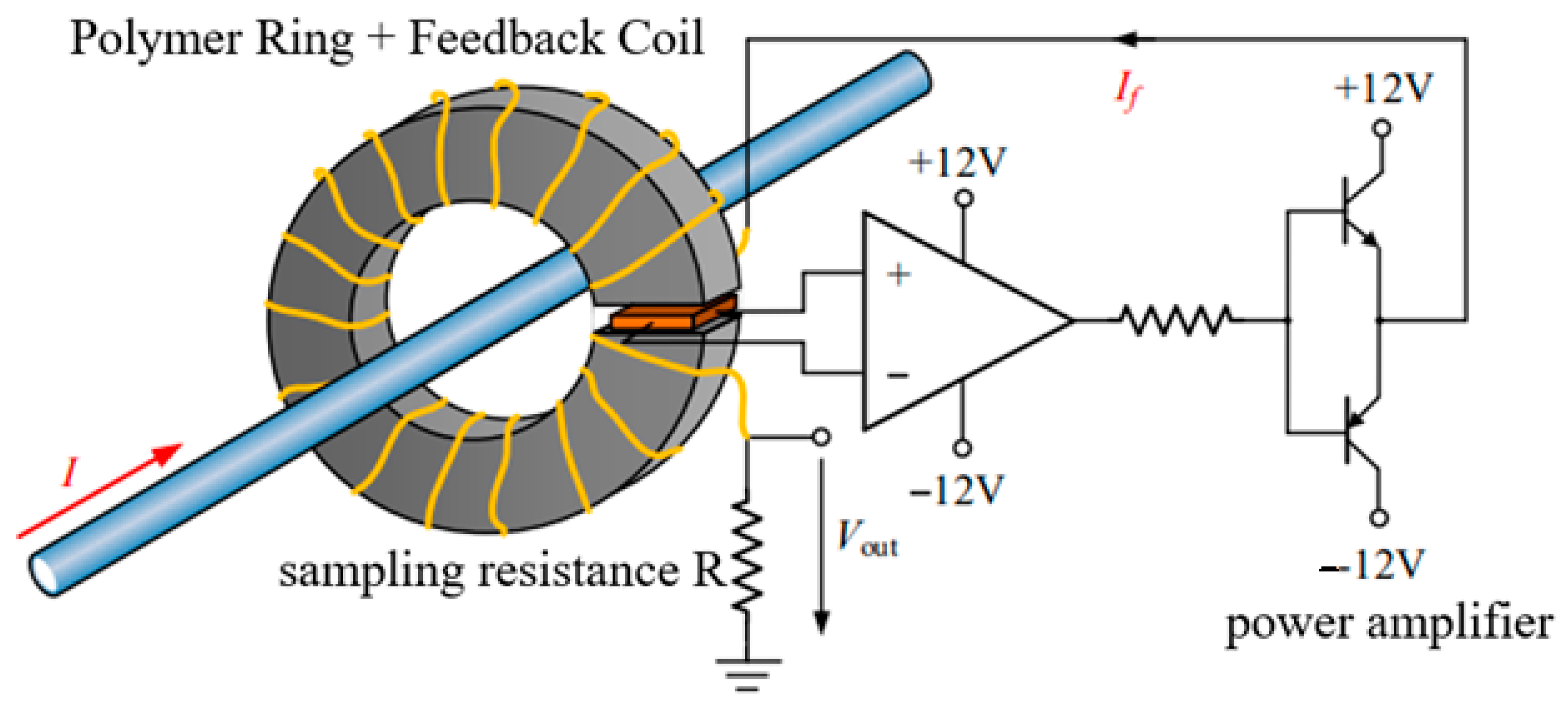



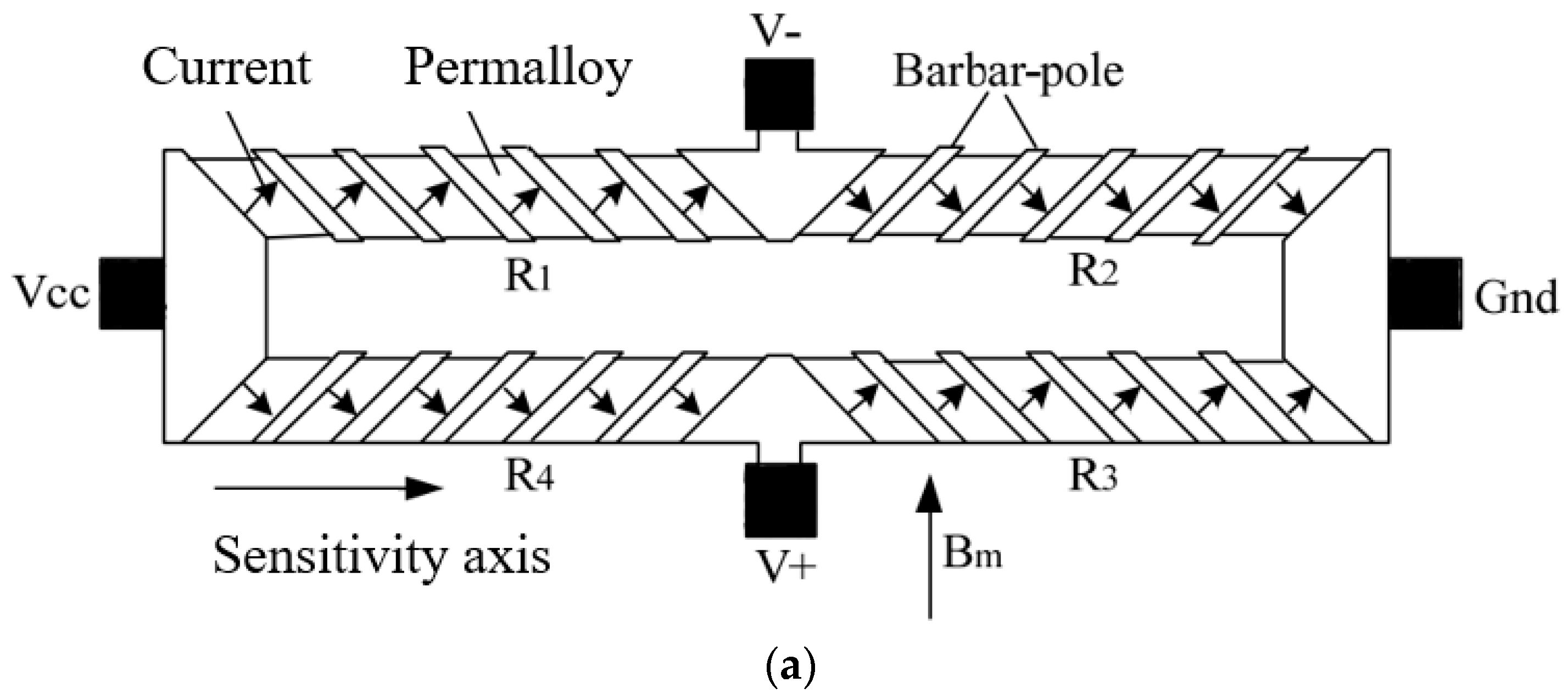


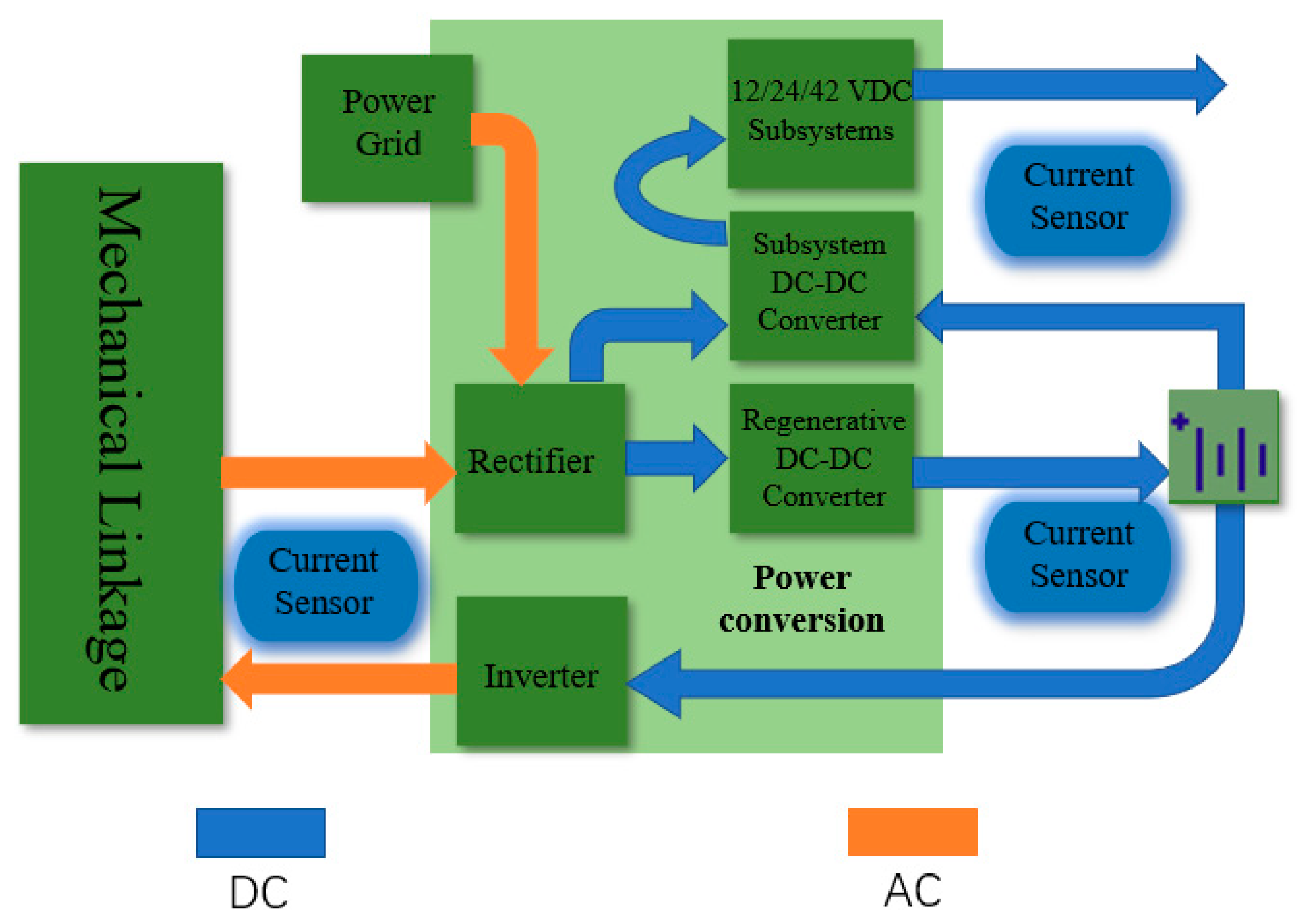



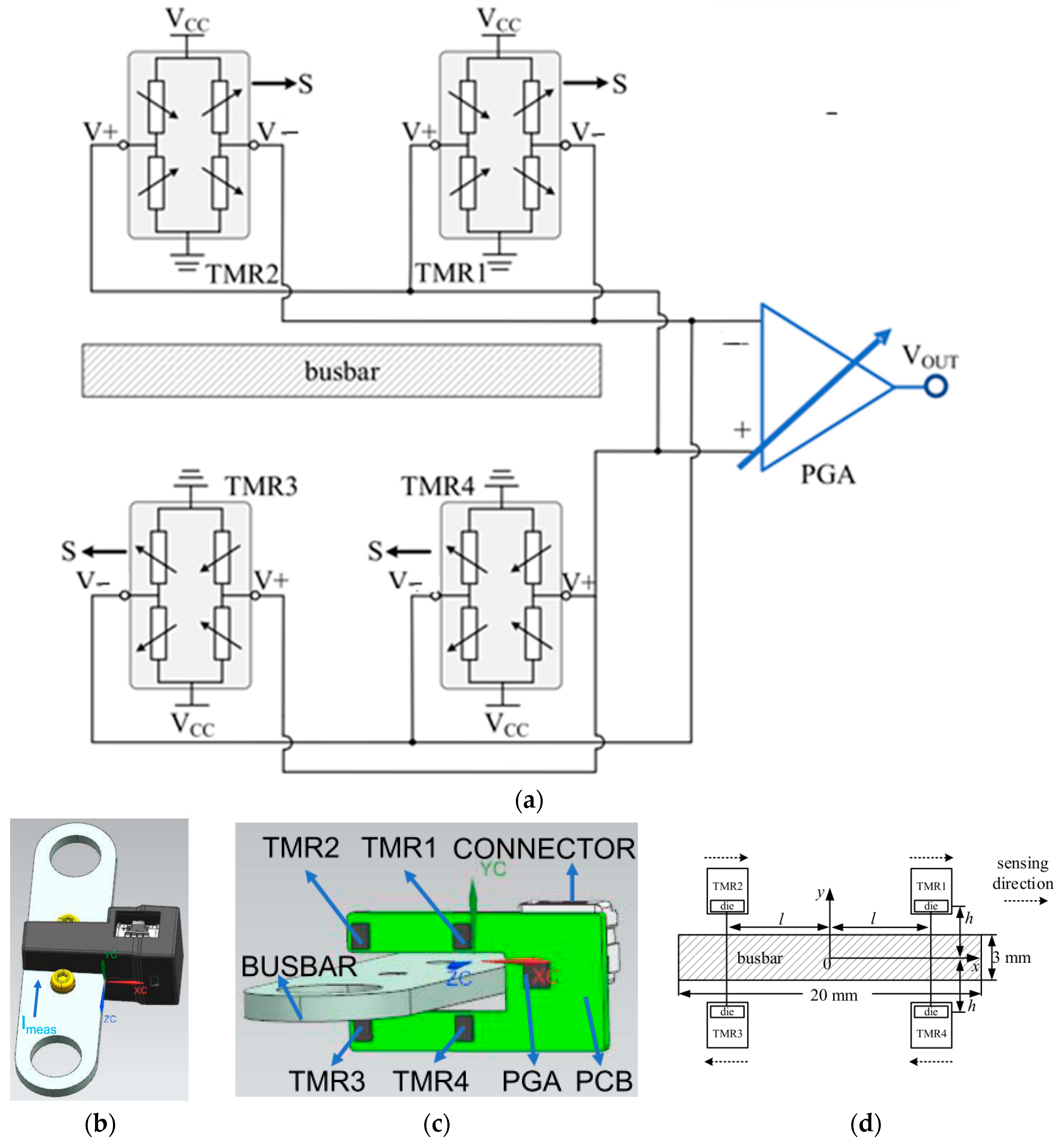
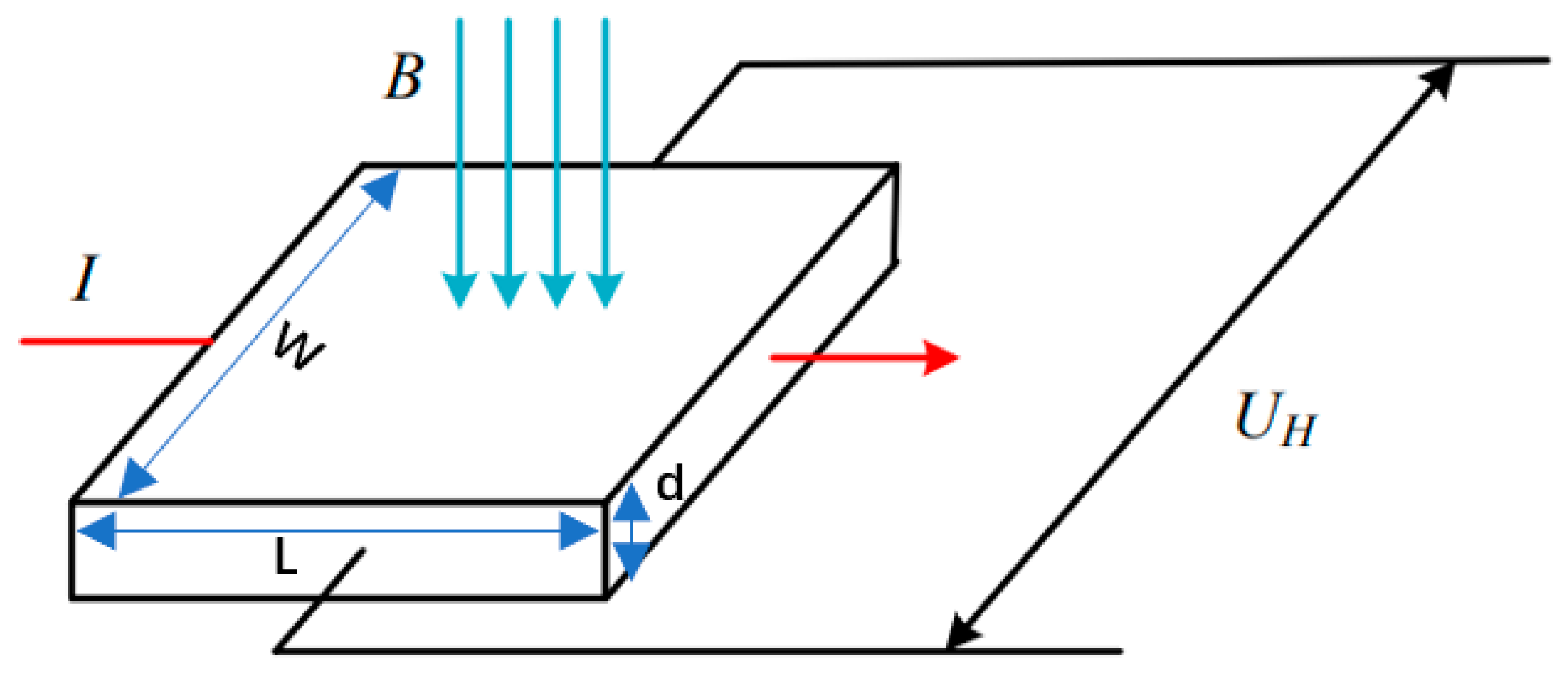


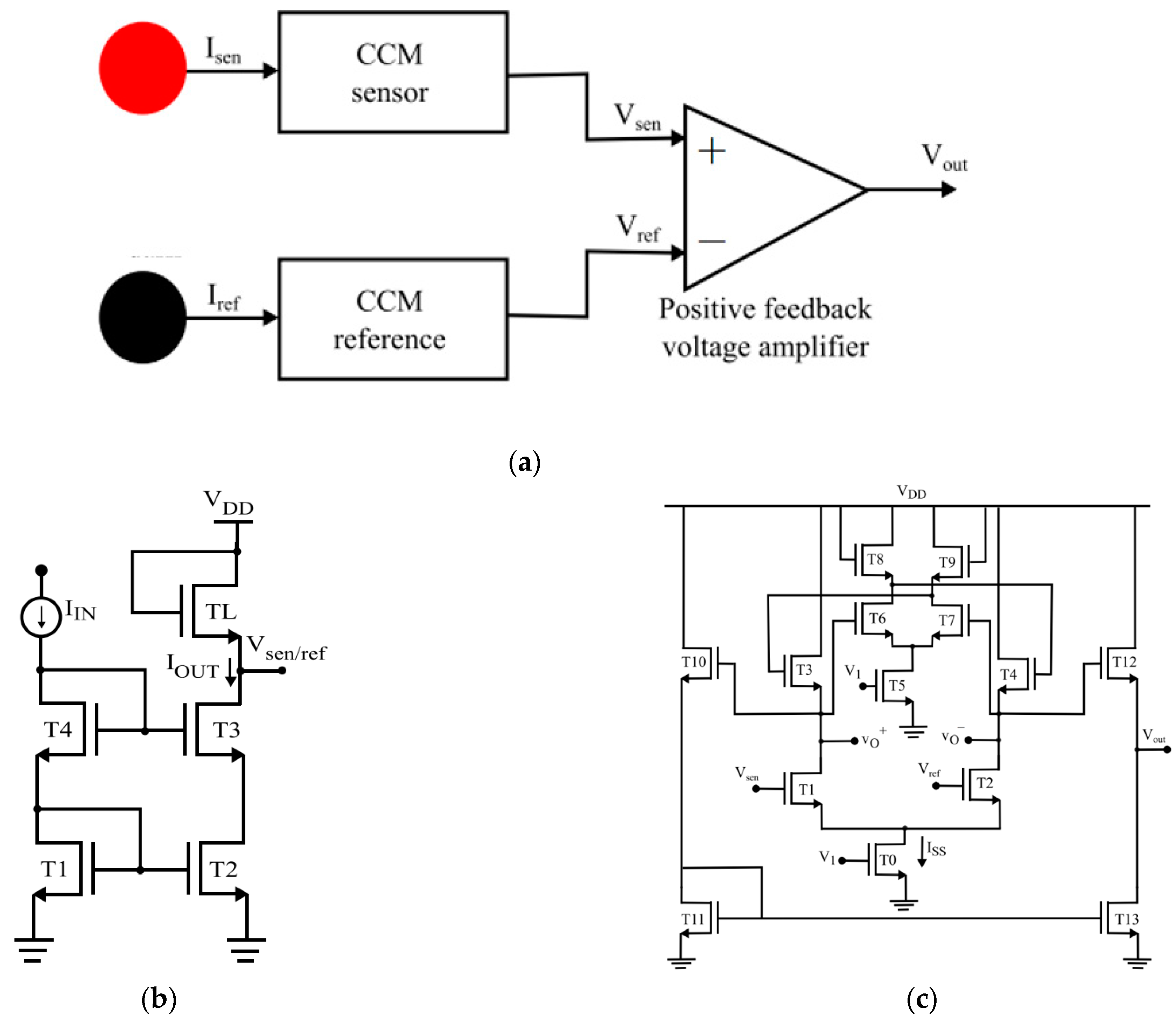
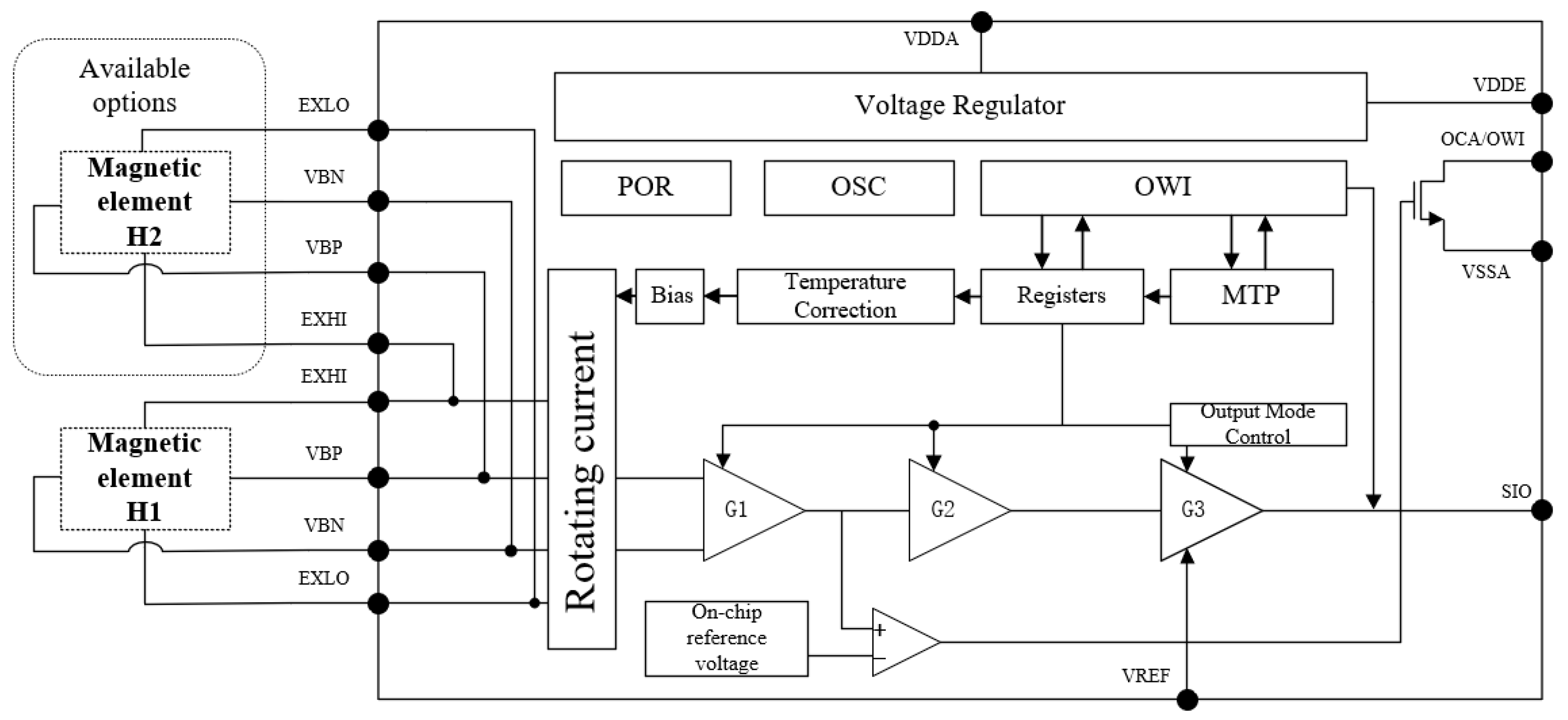
| Structure Type | Open-Loop Architecture | Closed-Loop Architecture | Array Structure |
|---|---|---|---|
| Measurement range | small | large | medium |
| Design difficulty | small | large | medium |
| Power wastage | low | high | medium |
| Sensitivity | medium | high | medium |
| Accuracy | low | high | high |
| Iron | Silicon Steel | Permalloy | Ferrite | Cobalt-Based Amorphous | Fe-Based Amorphous | Fe-Based Nanocrystals | |
|---|---|---|---|---|---|---|---|
| Saturated magnetic induction (T) | <2.16 | 2 | 0.5~1.5 | <0.5 | 0.5~0.8 | >1.5 | >1.2 |
| Coercivity (A/m) | <96 | <3 | >0.4 | 20 | <2 | <3 | <2 |
| Initial permeability | 1000 | >10,000 | 2000 | >30,000 | >1000 | >80,000 | |
| Maximum permeability | 20,000 | >10,000 | >200,000 | >200,000 | >200,000 | >200,000 |
| Sensors | Volumetric | Bandwidth | Measurement Range/mT | Applicable Temperature/°C | Sensitivity (mV/V/Oe) |
|---|---|---|---|---|---|
| Hall | Very small | DC-150 kHz | 0.1–100 | <150 | 0.05 |
| AMR | Very small | DC-MHz | 0.0001–1 | <150 | 1 |
| GMR | Small | DC-MHz | 0.01–3 | <150 | 3 |
| TMR | Infinitesimal | DC-MHz | 0.0001–20 | <200 | 20 |
Disclaimer/Publisher’s Note: The statements, opinions and data contained in all publications are solely those of the individual author(s) and contributor(s) and not of MDPI and/or the editor(s). MDPI and/or the editor(s) disclaim responsibility for any injury to people or property resulting from any ideas, methods, instructions or products referred to in the content. |
© 2024 by the authors. Licensee MDPI, Basel, Switzerland. This article is an open access article distributed under the terms and conditions of the Creative Commons Attribution (CC BY) license (https://creativecommons.org/licenses/by/4.0/).
Share and Cite
Yang, Z.; Jiang, Y. Prospective Review of Magneto-Resistive Current Sensors with High Sensitivity and Wide Temperature Range. J. Low Power Electron. Appl. 2024, 14, 43. https://doi.org/10.3390/jlpea14030043
Yang Z, Jiang Y. Prospective Review of Magneto-Resistive Current Sensors with High Sensitivity and Wide Temperature Range. Journal of Low Power Electronics and Applications. 2024; 14(3):43. https://doi.org/10.3390/jlpea14030043
Chicago/Turabian StyleYang, Zicai, and Yanfeng Jiang. 2024. "Prospective Review of Magneto-Resistive Current Sensors with High Sensitivity and Wide Temperature Range" Journal of Low Power Electronics and Applications 14, no. 3: 43. https://doi.org/10.3390/jlpea14030043
APA StyleYang, Z., & Jiang, Y. (2024). Prospective Review of Magneto-Resistive Current Sensors with High Sensitivity and Wide Temperature Range. Journal of Low Power Electronics and Applications, 14(3), 43. https://doi.org/10.3390/jlpea14030043







